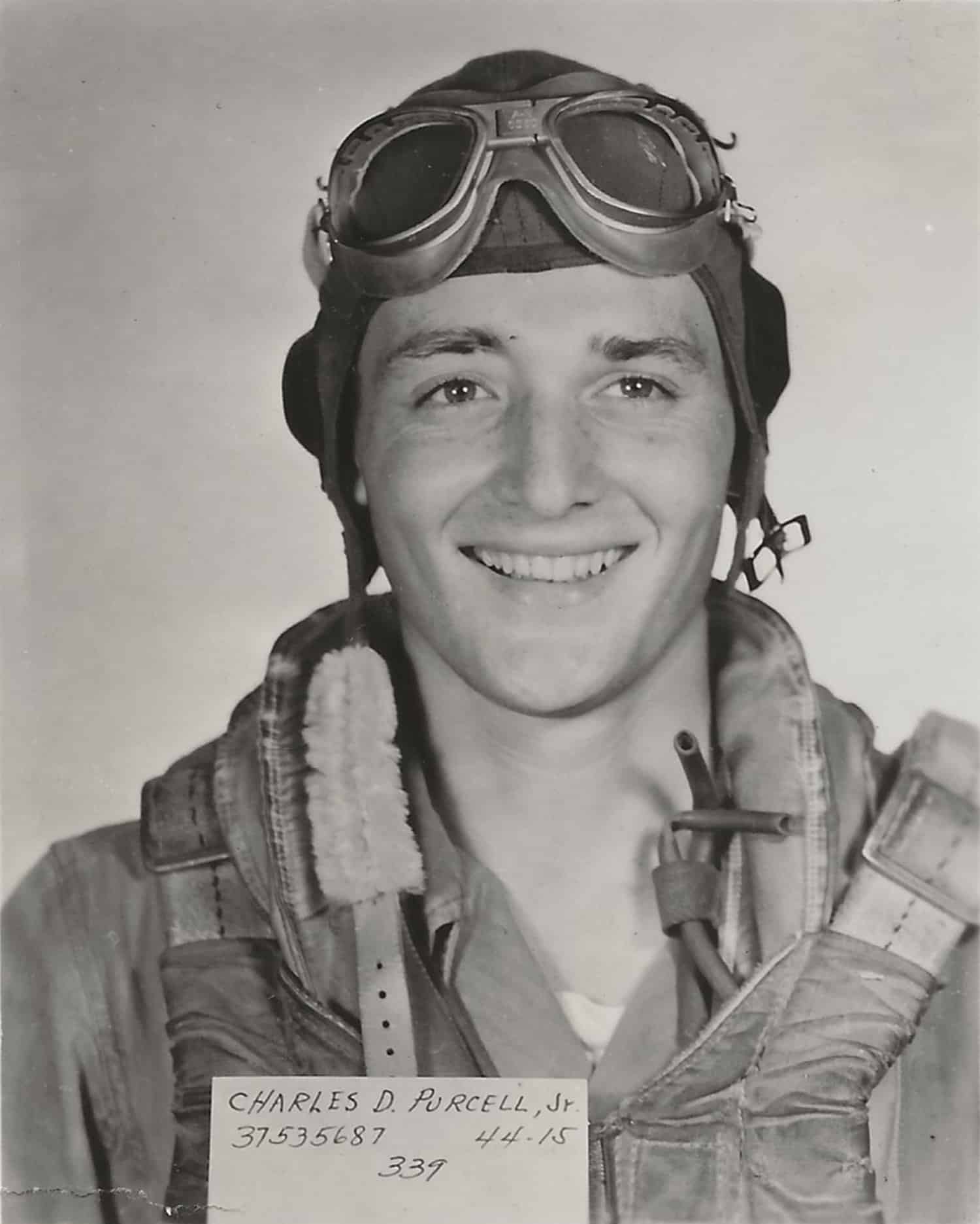Every Veterans Day, we honor those who served our country for their patriotism, love of country, and willingness to sacrifice to preserve our freedom. This Veterans Day, we honor Sgt. Charles “Chuck” Purcell Jr., a U.S. Army Air Corp World War II veteran.
Chuck and his twin brother, Warren, were born in Kansas City, Missouri in 1925. The morning of December 7, 1941, Chuck came home from church and sat down in the living room with his parents, twin brother, and little sister to listen to the radio as usual, and news about Pearl Harbor started coming in. Chuck remembers, “And of course, we stuck by that radio for hours listening to it. My brother and I were 16 at the time. And when we turned 17 on April 15, 1942, we tried to talk our folks into letting us go into the service, and they would not give us permission. So, we both decided we’d go to college for one year until we were 18.” So, they enrolled at Kansas City (Kansas) Junior College, and when they turned 18 on April 15, 1943, they registered with the draft and went into service in July 1943.
Both Chuck and Warren wanted to join the U.S. Army Air Corps (now the Air Force), which required a color vision test, and both brothers were color blind. Chuck explains, “My girlfriend at the time, her parents knew of a doctor who could cure eye color blindness or said he could, and I had gone to several different meetings with him.” For the color vision test you have to be able to identify the number on each plate. Chuck continues, “And I memorized the book, not on purpose, but I’d seen it enough. So, when we went through basic training at Fort Leavenworth, Kansas and were given the test, I passed and my brother Warren didn’t…they put him in the infantry. As time went by then my memory started to slip, and when I was in basic training in Amarillo, Texas, and they checked us again, I missed some of the numbers. I thought that guy was going to have a heart attack, he got so excited. He opened the journal and started bringing out nothing but pastel colors. I flunked badly.” And that’s how Chuck became a belly gunner.
Chuck recalls, “From there, I went to Larry Field, Colorado, which at that time was a very active air base, into what they call an armament program, teaching you how to service 50 caliber machine guns, load bomb racks. And I got to love Denver. People treated us so well.”
After that Chuck went to Harlingen Army Gunnery School in Harlingen, Texas. When he graduated, they pinned his wings on him and then he heard ‘Corporal Purcell’ along with the name of another classmate called over the loudspeaker. Chuck says, “So we went to the commanding officer’s office, and he said, ‘you two are the outstanding two gunners in this class. And, I want to send you to instructor gunnery school.’ As we walked away I thought, ‘oh, gosh, I must have been terrible.’”
His next stop was Fort Moore in Fort Myers, Florida, where he went through two weeks of instruction. Chuck recalls, “And the Army has a great way of teaching. Yes, tell it often enough. And I remember that it was repetition and repetition and repetition.” After that, Chuck was off to Casper, Wyoming as a hot air gunnery instructor. Chuck remembers, “that was probably the most dangerous job I’ve ever had in my life and didn’t realize at the time.”
While he was in Casper, his mother took the train up to come visit him from Kansas City. Chuck recalls, “I went back to the base that evening, and the lights were still on. And I thought, ‘this is funny’ because we had early morning briefings at 2 am, but the guys were all still up. I walked in, and they told me that I had volunteered to go overseas.”
Chuck went to Italy with the Fifteenth Air Force (15th AF) as a belly gunner. The 15th AF was composed of all B-24s with the exception of one squadron of B-17s. Chuck explains, “Every place on those planes was dangerous, but the ball turret was below and planes coming from underneath would take a first crack at the ball turret. And I had difficulty getting out if we lost power. I couldn’t come out unless one of my buddies up above could crank me out. And we couldn’t wear a parachute in there. It was a lot worse than I thought it was going to be. I’d seen movies, but you just can’t ever believe it. And it’s not only sight and sound, you get a lot of turbulence from those shells bursting when they land. And it was so cold. You’re at 20,000 feet, it’s 30, 40 degrees below zero. And no insulation in the planes. If it’s 30 degrees below zero outside, it’s 30 degrees below zero inside.”
His brother, Warren was a staff sergeant in the infantry in the Seventh Army with General Patch. Chuck explains, “They landed at Marseilles and worked their way up through southern France. Winter was terrible. And if you look at a map from Marseilles to Strasbourg is a long way. And they did it on foot and under fire an awful lot. He and I would exchange letters as well as we could. I got one letter from him that said ‘last night, I slept above ground for the first time in weeks. I found a pigeon coop, and I slept in a pigeon coop.’ He had frostbite. They didn’t have any winter equipment. When I would read his letters, I’d think, ‘Oh, I am so lucky. If I get back to base, I’ve got my own cot to sleep on. I’ve got my own mess hall to go to for meals. I’ve got friends around me. Nobody’s going to shoot me during the night.’” Warren was killed in action in France in March 1945.
Chuck left Italy on July 4, 1945 and was supposed to head to the South Pacific after a 30-day rehabilitation furlough at home. Three days before he had to report to the Santa Ana Air Force Base, Victory over Japan was announced. Chuck was discharged from service in November 1945.
After the war, Chuck went to college at Northwestern University, opened his own carpet business, married, and raised a family.
About six or seven years after his brother, Warren, was killed, Chuck was in Wichita having an early morning breakfast at a hotel with a carpet salesman. Chuck recalls, “I was in the restaurant having breakfast, and I noticed a couple sitting a couple tables away from us. I could see the guy look over and then he got up, walked over, and pulled out a chair. And he said ‘I was with your brother the day he was killed.’”
Chuck continues, “Now you want to have us something strike you hard? That was it. I talked to him, and I was just shocked. And he gave me details, and unfortunately, I didn’t get his name. I didn’t get an address for him. Anything. And he didn’t ask me if my last name was Purcell or anything.”
When Chuck was stationed at Lowry Field in Colorado during his early military training he vowed that one day he’d go back to live in Colorado.’ Ten years before that in 1934, Chuck visited Evergreen with his mother and twin brother, spending the summer along Cub Creek. In 1972, Chuck made good on that vow and moved his family to Evergreen, where he lived until his passing in November 2023. It was Mount Evans’ honor to care for him in his final years.
Mount Evans Home Health Care & Hospice provides experienced and compassionate in-home health and hospice care to the foothills and mountain communities in Clear Creek, Gilpin, Jefferson, and Park counties. Its clinical care team received veteran-centric education as part of We Honor Veterans, a National Hospice and Palliative Care Organization program associated with the Department of Veterans Affairs.
A version of this article will appear in the November issue of Colorado Serenity Magazine.



